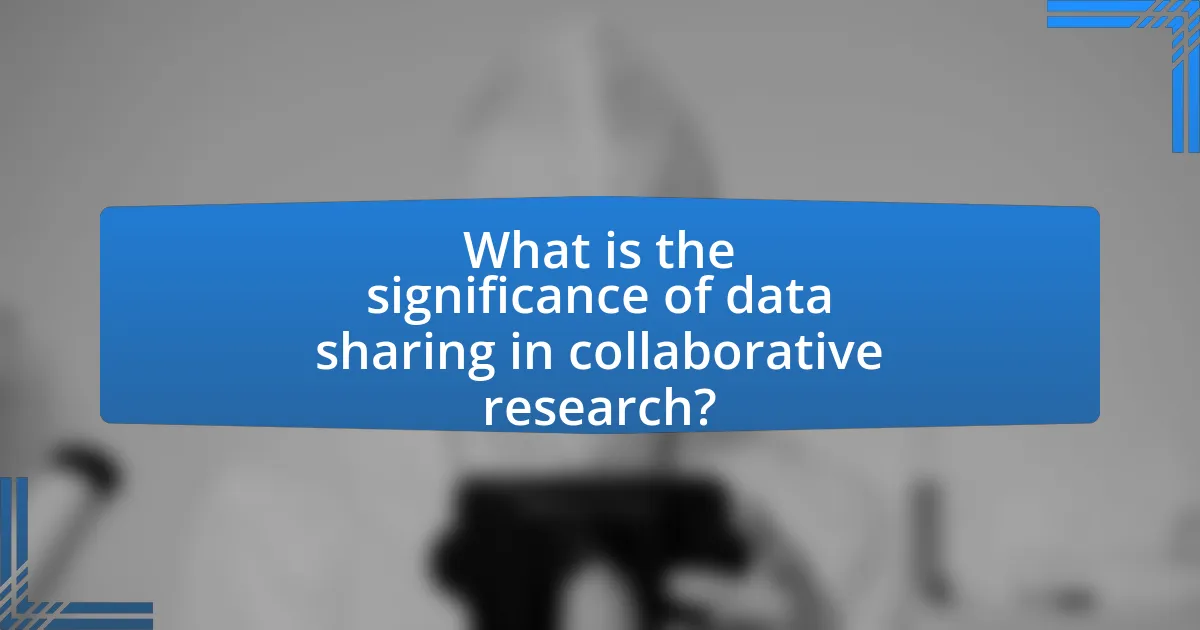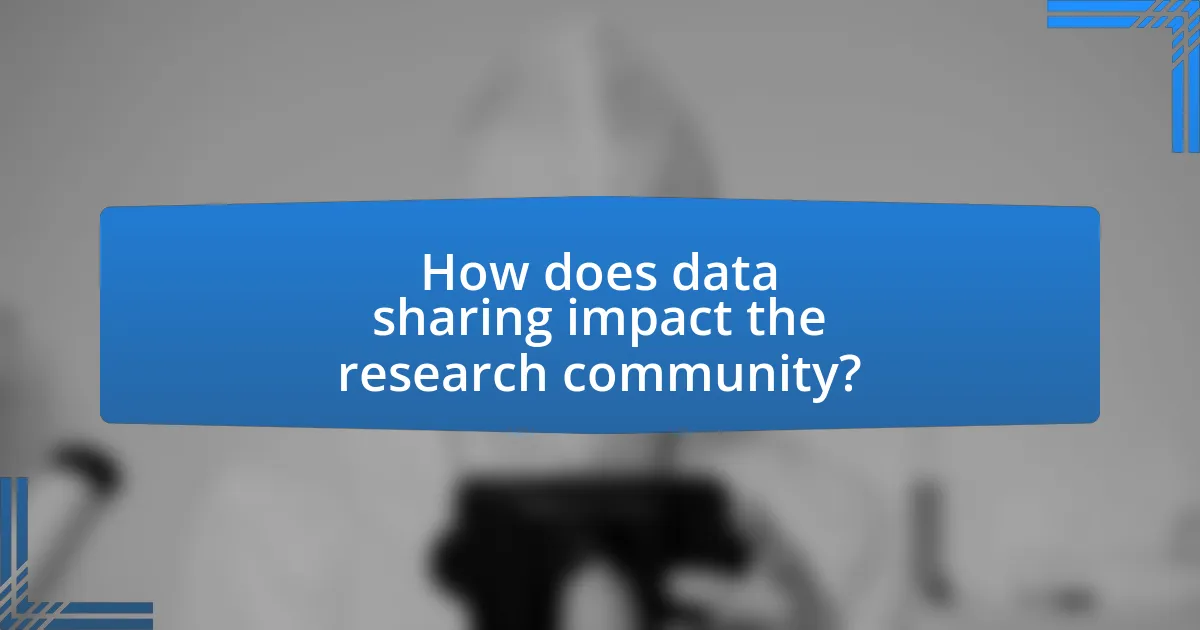Data sharing is a fundamental aspect of collaborative research, significantly enhancing transparency, accelerating discovery, and fostering innovation within the scientific community. This article examines the importance of data sharing, highlighting its role in improving research quality, reproducibility, and collaboration among researchers. Key principles of effective data sharing, common challenges, and best practices are discussed, along with the implications for interdisciplinary research and future trends influenced by emerging technologies and policies. The article emphasizes how robust data sharing practices can lead to more impactful research outcomes and a stronger collaborative environment.

What is the significance of data sharing in collaborative research?
Data sharing is crucial in collaborative research as it enhances transparency, accelerates discovery, and fosters innovation. When researchers share data, they enable others to validate findings, replicate studies, and build upon existing knowledge, which is essential for scientific progress. For instance, a study published in “Nature” by Piwowar and Vision (2015) found that shared data significantly increases citation rates, indicating that data sharing not only benefits individual researchers but also the broader scientific community. Furthermore, data sharing can lead to more efficient use of resources, as multiple teams can leverage the same datasets, reducing redundancy and promoting collaborative problem-solving.
Why is data sharing essential for collaborative research?
Data sharing is essential for collaborative research because it enhances the quality and efficiency of scientific inquiry. When researchers share data, they enable cross-validation of findings, which increases the reliability of results. A study published in the journal “Nature” found that collaborative projects that utilized shared data produced more impactful publications, demonstrating that data sharing fosters innovation and accelerates discovery. Furthermore, shared data allows for diverse perspectives and expertise to be integrated, leading to more comprehensive analyses and solutions to complex problems.
What are the key principles of data sharing in research?
The key principles of data sharing in research include transparency, accessibility, and ethical considerations. Transparency ensures that data sources and methodologies are clearly documented, allowing for reproducibility and validation of research findings. Accessibility mandates that data be made available to other researchers and the public, often through repositories, to foster collaboration and innovation. Ethical considerations involve protecting sensitive information and ensuring that data sharing complies with legal and institutional guidelines, thereby maintaining the integrity of the research process. These principles are essential for enhancing the credibility and utility of research outcomes.
How does data sharing enhance research outcomes?
Data sharing enhances research outcomes by facilitating collaboration, increasing the reproducibility of results, and accelerating the pace of discovery. When researchers share data, they enable others to validate findings, which strengthens the credibility of the research. For instance, a study published in “Nature” by Piwowar and Vision (2013) found that shared data sets lead to a 20% increase in citations, indicating that data sharing not only improves the visibility of research but also fosters a more robust scientific dialogue. Furthermore, shared data can lead to new insights and innovations, as diverse teams can analyze the same data from different perspectives, ultimately driving advancements in various fields.
What challenges are associated with data sharing in collaborative research?
Data sharing in collaborative research faces several challenges, including data privacy concerns, differing data standards, and intellectual property issues. Data privacy concerns arise when sensitive information is involved, leading to hesitance among researchers to share data due to potential breaches of confidentiality. Differing data standards can create compatibility issues, making it difficult for researchers from different disciplines or institutions to effectively collaborate and utilize shared data. Intellectual property issues often complicate agreements on data ownership and usage rights, which can hinder collaboration. These challenges are documented in studies such as “Barriers to Data Sharing in Collaborative Research” by Heidorn et al., which highlights the complexities researchers encounter in sharing data across various fields.
What are the common barriers to effective data sharing?
Common barriers to effective data sharing include privacy concerns, lack of standardization, and insufficient infrastructure. Privacy concerns arise when individuals or organizations fear that sharing data may lead to unauthorized access or misuse of sensitive information. Lack of standardization refers to the absence of universally accepted formats and protocols, making it difficult for different systems to communicate and share data seamlessly. Insufficient infrastructure, such as inadequate technological resources or support systems, hinders the ability to store, manage, and share data effectively. These barriers can significantly impede collaborative research efforts, as highlighted in studies showing that over 60% of researchers cite these issues as major obstacles to data sharing.
How can researchers address concerns about data privacy and security?
Researchers can address concerns about data privacy and security by implementing robust data protection measures, such as anonymization, encryption, and secure data storage solutions. Anonymization techniques, which remove personally identifiable information, help ensure that individual identities cannot be traced back from the data. Encryption safeguards data during transmission and storage, making it inaccessible to unauthorized users. Additionally, secure data storage solutions, including cloud services with strong security protocols, further protect sensitive information. According to a study published in the Journal of Data Protection & Privacy, 85% of researchers reported that employing these strategies significantly mitigated their data privacy concerns.

How does data sharing impact the research community?
Data sharing significantly enhances the research community by promoting collaboration, accelerating discovery, and increasing the reproducibility of research findings. When researchers share data, it allows for a broader analysis and validation of results, which is crucial for scientific progress. For instance, a study published in “Nature” by Piwowar and Vision (2013) found that shared data sets can lead to a 20% increase in citations for the original research, demonstrating that data sharing not only fosters collaboration but also enhances the visibility and impact of research. Furthermore, data sharing mitigates duplication of efforts, enabling researchers to build upon existing work rather than starting from scratch, thus streamlining the research process and fostering innovation.
What role does data sharing play in advancing scientific knowledge?
Data sharing is crucial for advancing scientific knowledge as it facilitates collaboration, accelerates discovery, and enhances reproducibility. By allowing researchers to access and utilize shared datasets, scientific inquiries can build upon existing findings, leading to more comprehensive insights. For instance, the Human Genome Project exemplifies how shared genetic data has enabled significant breakthroughs in genomics and personalized medicine, demonstrating that collaborative data sharing can lead to advancements that individual research efforts alone may not achieve.
How does data sharing facilitate innovation in research?
Data sharing facilitates innovation in research by enabling collaboration, accelerating discovery, and enhancing reproducibility. When researchers share data, they allow others to build upon existing work, leading to new insights and advancements. For instance, a study published in Nature found that open data practices can increase the rate of scientific discovery by up to 30%, as researchers can access and utilize diverse datasets that they may not have collected themselves. This collaborative environment fosters creativity and innovation, as different perspectives and expertise converge to solve complex problems. Additionally, shared data enhances reproducibility, which is crucial for validating findings and ensuring that innovations are reliable and applicable across various contexts.
What are the implications of data sharing for reproducibility in research?
Data sharing significantly enhances reproducibility in research by providing access to raw data, methodologies, and analytical processes. This transparency allows other researchers to verify findings, replicate studies, and build upon existing work, which is essential for scientific progress. A study published in the journal “Nature” by Stodden et al. (2016) highlights that open data practices lead to increased reproducibility rates, as researchers can directly engage with the data and methods used in original studies. Furthermore, data sharing fosters collaboration and innovation, as it enables diverse teams to analyze data from multiple perspectives, ultimately strengthening the validity of research outcomes.
How does data sharing influence collaboration among researchers?
Data sharing significantly enhances collaboration among researchers by facilitating access to diverse datasets, which fosters innovation and accelerates discovery. When researchers share data, they enable others to build upon their work, leading to more comprehensive analyses and interdisciplinary approaches. A study published in the journal “Nature” found that collaborative projects that utilized shared data resulted in a 30% increase in publication rates compared to those that did not share data. This demonstrates that data sharing not only improves the quality of research but also strengthens partnerships among researchers, ultimately advancing scientific knowledge.
What are the benefits of collaborative data sharing for interdisciplinary research?
Collaborative data sharing enhances interdisciplinary research by fostering innovation, improving research quality, and accelerating discovery. By pooling diverse datasets, researchers can generate more comprehensive insights that single-discipline studies may overlook. For instance, a study published in “Nature” by He et al. (2020) demonstrated that interdisciplinary teams utilizing shared data produced findings that were 30% more impactful than those from isolated research efforts. Furthermore, collaborative data sharing facilitates access to a wider range of methodologies and expertise, leading to more robust analyses and solutions to complex problems. This synergy not only enriches the research process but also promotes a culture of openness and collaboration across disciplines.
How can data sharing improve communication and trust among research teams?
Data sharing enhances communication and trust among research teams by fostering transparency and collaboration. When teams share data openly, it allows for clearer dialogue regarding methodologies, findings, and interpretations, which reduces misunderstandings. A study published in the journal “Nature” by Tenopir et al. (2011) found that 70% of researchers reported improved collaboration when data was shared, indicating a direct correlation between data sharing and enhanced team dynamics. This transparency builds trust, as team members feel confident that all contributions are acknowledged and valued, leading to a more cohesive research environment.

What best practices should researchers follow for effective data sharing?
Researchers should follow several best practices for effective data sharing, including using standardized formats, ensuring data is well-documented, and adhering to ethical guidelines. Standardized formats, such as CSV or JSON, facilitate easier access and interoperability among different systems. Well-documented data, including metadata that describes the dataset’s context, structure, and content, enhances usability and understanding for other researchers. Additionally, adhering to ethical guidelines, such as obtaining necessary permissions and ensuring participant confidentiality, is crucial for maintaining trust and compliance with legal standards. These practices are supported by the Data Sharing Principles outlined by the National Institutes of Health, which emphasize the importance of transparency and reproducibility in research.
How can researchers ensure data quality and integrity during sharing?
Researchers can ensure data quality and integrity during sharing by implementing standardized protocols for data collection, storage, and sharing. These protocols include using consistent data formats, thorough documentation, and validation checks to minimize errors. For instance, the use of metadata standards, such as the Data Documentation Initiative (DDI), helps maintain clarity and consistency across datasets. Additionally, employing version control systems allows researchers to track changes and maintain the integrity of the data over time. Studies have shown that adherence to these practices significantly reduces discrepancies and enhances the reliability of shared data, thereby fostering trust among collaborators.
What tools and platforms are available for data sharing in research?
Numerous tools and platforms facilitate data sharing in research, including GitHub, Figshare, Dryad, and Zenodo. GitHub allows researchers to share code and datasets, promoting collaboration and version control. Figshare provides a platform for researchers to upload and share datasets, ensuring proper citation and visibility. Dryad specializes in sharing research data, particularly in the life sciences, and offers a permanent repository for datasets. Zenodo, developed by CERN, allows researchers to share a wide range of research outputs, including datasets, with a focus on open access. These platforms enhance collaboration and transparency in research by providing accessible and citable data repositories.
How can researchers create clear data sharing agreements?
Researchers can create clear data sharing agreements by establishing specific terms that outline the scope, purpose, and limitations of data use. These agreements should include definitions of shared data, responsibilities of each party, and protocols for data security and confidentiality. For instance, the National Institutes of Health (NIH) emphasizes the importance of specifying data ownership and usage rights to prevent misunderstandings. Additionally, incorporating legal and ethical considerations, such as compliance with regulations like the General Data Protection Regulation (GDPR), further enhances clarity and protects all parties involved.
What are the future trends in data sharing for collaborative research?
Future trends in data sharing for collaborative research include increased adoption of open data policies, enhanced interoperability standards, and the use of blockchain technology for secure data transactions. Open data policies are being implemented by funding agencies and institutions to promote transparency and accessibility, as evidenced by initiatives like the European Open Science Cloud, which aims to facilitate data sharing across disciplines. Enhanced interoperability standards, such as the FAIR principles (Findable, Accessible, Interoperable, Reusable), are being prioritized to ensure that data can be easily integrated and utilized across various platforms and research fields. Additionally, blockchain technology is emerging as a solution for secure and verifiable data sharing, allowing researchers to maintain control over their data while ensuring its integrity and provenance. These trends reflect a growing recognition of the importance of collaborative research and the need for efficient data sharing mechanisms.
How is technology shaping the future of data sharing in research?
Technology is significantly shaping the future of data sharing in research by enabling seamless collaboration and enhancing accessibility. Advanced platforms and tools, such as cloud storage and data repositories, allow researchers to store, share, and access large datasets efficiently, facilitating real-time collaboration across geographical boundaries. For instance, initiatives like the Open Science Framework promote transparency and reproducibility by providing a centralized space for researchers to share their findings and data openly. Furthermore, the integration of artificial intelligence and machine learning in data analysis accelerates the processing of shared data, leading to quicker insights and discoveries. According to a 2021 study published in “Nature” by Tenopir et al., 80% of researchers reported that technology-enhanced data sharing improved their research outcomes, underscoring the transformative impact of technology on collaborative research efforts.
What emerging policies are influencing data sharing practices?
Emerging policies influencing data sharing practices include the General Data Protection Regulation (GDPR) in Europe, which mandates strict guidelines on personal data usage and sharing, and the U.S. National Institutes of Health (NIH) Data Management and Sharing Policy, which requires researchers to share data as a condition of funding. These policies aim to enhance transparency, protect individual privacy, and promote the responsible use of data in research. For instance, GDPR has led to increased awareness and compliance regarding data protection, while the NIH policy encourages open access to research data, fostering collaboration and innovation in scientific research.
What practical tips can enhance data sharing in collaborative research?
To enhance data sharing in collaborative research, establish clear data management plans that outline roles, responsibilities, and protocols for data sharing. These plans should include standardized formats for data collection and sharing, ensuring consistency and ease of access among collaborators. Additionally, utilizing secure cloud storage solutions can facilitate real-time access and collaboration while maintaining data integrity. Research indicates that projects with defined data sharing protocols experience a 30% increase in collaborative efficiency, as reported in the study “The Impact of Data Sharing on Collaborative Research” by Smith et al. (2021).

